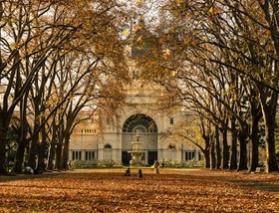
“[God] hath made every thing beautiful in his time” (Ecclesiastes 3:11). The bible’s word division is meaningful. Every thing is individually beautiful, not absorbed into an overall label of beauty. Every one of God’s creations can bring beauty and meaning into our lives. When I need to renew inspiration and strength, I find myself blessed with Christ’s comfort in looking to four large trees in my own front yard.
Meaning in Trees
Christ often spoke of an item or process in nature, including trees, so His listeners might be blessed with understanding of complex teachings. As a child I learned about the mustard grain, “the least of all seeds,” that would grow into a huge tree (Matthew 17:20). Now as I am studying about the history of Israel, Christ’s detailed analogy of Israel to the tree in the Master’s vineyard has deeper meaning (Jacob 5). As today’s world becomes more terrifying, the parable of the fig tree and others that “shoot forth” as signs of a yearly season instruct us how to look toward more trying times ahead (Luke 21:30).
My four large sentinels are two tall Bradford pear trees, a plum tree, and a large fir tree. Though their particular varieties do not bear fruit, all of them bring joy. Every one in its own way has blessed our family with beauty, joy and understanding.
Blessed With Beauty
We all need beauty, to make our joy more full and our problems more bearable. Natural beauty reassures us that God is with us. Radiant white blossoms on the pear trees and vivid deep pink flowers on the plum tree have always been a joyful reminder that spring is coming, although Utah’s weird weather can bring snow after blossoms as well as warm weather on Christmas.
At all times and ages, my children and I have rejoiced together in the beauty of the trees. Excited young children or anxious, world-weary teenagers could still gasp “wow!” or “gorgeous!” In happy times or frustrating needs, we could pause for a moment of joy.
During the time when our lives were absorbed—physically, mentally, and emotionally—by the COVID pandemic, I could step away from my full-day computer work—without benefits of students, colleagues, and hallways—to gaze at my trees. Whether they were covered with spring blossoms, summer leaves, or fall colors, I would be comforted that with the presence of the all-knowing, all-wise, and perfectly loving God, the world was not out of control. My children, now adults, still enjoy visiting our trees.
Blessed With Understanding
My house is not large, but my trees are. My house is not unusual or impressive, but my trees are ideally suited to the family that has lived with them. The plum tree is shorter and stockier than the others, with thick branches that can be easily climbed and sat upon. All of my children have enjoyed climbing.
One of my daughters and a couple of her friends liked to climb into the plum tree, perch on the branches, and sing songs they learned in church lessons, especially “I Am A Child of God.” Like most parents, I had days that I had to be reminded that all three of these enthusiastic singers were indeed children of God—mud, noise, clutter, and all.
This daughter now has a small boy who loves to play among the trees in their family’s Florida yard. One of his tree fantasies included trying to drag his small suitcase behind him up a favorite tree. He too is a beloved child of God.
As we’ve survived many severe winter storms together, I’ve learned a necessary lesson from one of the pear trees, which happens to be located where it catches harder wind and more snow than the others. All the trees have lost a few branches in storms, but this one has lost a lot of branches, and at one time it seemed to have been torn into two pieces. Despite being a little misshapen, it just keeps growing and blooming, as we need to do when we are battered. The tree has survived, and so have I. I’m probably naive to feel safe leaning on the height and sturdiness of my trees, but I do.
Blessed With Life
We are all blessed with a tree that can begin, according to Alma (32:41), with a tiny seed of faith. If we nourish the seed with diligence and patience, it will put down roots and become “a tree springing up unto everlasting life.” Lehi and Nephi both saw the tree of life in visions. Nephi recognized that it represents “the love of God, which sheddeth itself abroad in the hearts of the children of men; wherefore, it is the most desirable of all things.” His angelic visitor added, “the most joyous to the soul.” This love is represented by its perfectly pure white fruit as well.
Regardless of our surroundings and challenges, we must carry the image of the tree of life in our hearts and minds, remembering always Christ’s love for us, and the wisdom, mercy, and perfection of His sacrifice.













